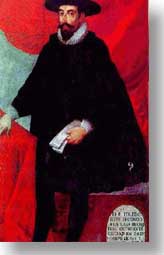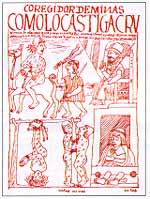
Theme Six: The Church and Religious Resistance
October 6-11
Midterm October 13

Outline:
A. The Structure of Labor/Politics
1. The Special Role of Curaca
2. Institutional Organization: The continued importance
of ayllu and alteptl
3. The "Spanish" Town in the New World
B. Conversion and Resistance
1.
The Structure of the Church in the New World
2.
The Mission of the Church
3. Resistance and the Taqui Onqoy
C.
Toledan Reforms
1. Mercury Amalgamation
2. Life
inside the "Red Mountain"
3. MigrationUrbanization and Indian Networks
4.
Taxation, Labor and Changes
and Ethnic Communities
5. Yanaconas and Forasteros
 This is a small version
of a page from Felipe Guaman Poma de Ayala's Buen Gobierno y Nueva Coronica
del Peru. Poma was a Christian mestizo who, in the early 17th
century, wrote a several-hundred-page "letter" to Philip V, King of Spain.
Each page of the cronicle contains a drawing of daily colonial life in
the Andes. The above page docments the cruel punishment of mitayos
at the hands of the mine corregidors. For more examples of
Guaman Poma's pages (text in Spanish), click
here.
This is a small version
of a page from Felipe Guaman Poma de Ayala's Buen Gobierno y Nueva Coronica
del Peru. Poma was a Christian mestizo who, in the early 17th
century, wrote a several-hundred-page "letter" to Philip V, King of Spain.
Each page of the cronicle contains a drawing of daily colonial life in
the Andes. The above page docments the cruel punishment of mitayos
at the hands of the mine corregidors. For more examples of
Guaman Poma's pages (text in Spanish), click
here.
Key Terms:
Mitayo |
Alcalde
Cabildo Audiencia Viceroyalty |
Potosí
Yanacona Forastero Captaincy |
Juez de Fora
Indian Reduction Repartimiento de la Mita (or, simply, Mita) |
Stern, pages 51-137 (Chapter Three, Four, and Five)
Optional Additional Readings:
Ann Wightman, Chapter Four "'El Ayllu Forastero': Migration, Community Structure and Identity" in Indigenous Migration and Social Change: The Forasteros of Cuzco (1991) pp.86-111.
Questions for Consideration:
1. How did the role of curaca change during the first one hundred years of colonial rule? Why do you think the position of curaca had not been dissolved completely by the Spanish after conquest? What does the colonial position of the curaca tell us about the nature of Spanish colonial rule?
2. How helpful is the term "indian" in understanding different groups
living in the rural societies of the bishopric of Cuzco during the late
seventeenth century? What are the alternatives, and what historical
phenomena do these alternatives highlight?
3. How did migration play a role in shaping social markers among indigenous
people?